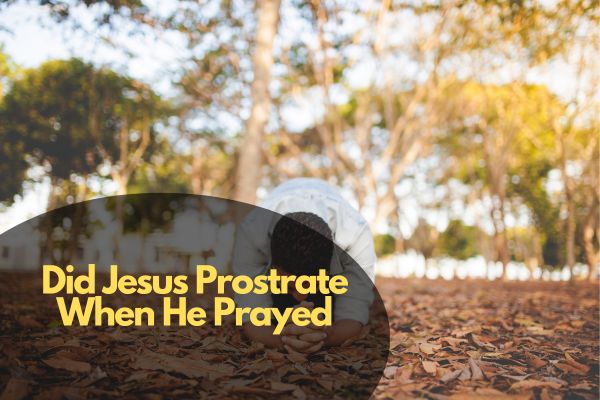Table of Contents Show
Venturing into the spiritual practices of Jesus, an exploration of the physical postures of prayer offers a profound dimension to our understanding. It beckons us to journey beyond the mere recitation of words, inviting a closer inspection of the intentional gestures that accompanied Jesus’ communion with the divine. To unravel the mysteries embedded in these prayer postures, one must embark on a multidimensional inquiry, considering historical context, scriptural references, and theological perspectives.
Did Jesus Prostrate When He Prayed?
The Bible does not explicitly mention Jesus prostrating during prayer. However, it does describe various postures of prayer that Jesus adopted. In the New Testament, particularly in the Gospels, Jesus is often depicted praying in a standing or kneeling position. For instance, in the Garden of Gethsemane, Jesus kneeled down in prayer before his arrest (Luke 22:41). Additionally, in the Gospel of Matthew, there are instances where Jesus prayed with his face to the ground, signifying deep reverence and humility (Matthew 26:39). While the term “prostration” may not be explicitly used, these passages suggest that Jesus employed different postures during prayer, reflecting the sincerity and gravity of his communion with God.
As we unravel the mysteries surrounding Jesus’ prayer postures, we embark on a profound journey of spiritual archaeology. It is a journey that requires a nuanced exploration of the historical, scriptural, and theological tapestry, each thread contributing to a richer comprehension of the spiritual practices of one of history’s most influential figures. Through this exploration, we discover that the postures of prayer were not just physical expressions but gateways to a deeper communion with the divine, offering contemporary believers an enduring legacy to ponder and embrace.
Historical Context of Prayer Postures
Biblical References to Jesus’ Prayers
Understanding Prostration in Prayer
Prostration, a physical act of humility and submission, is a common prayer posture across various religious traditions. Before looking into whether Jesus prostrated, we’ll explore the general meaning and cultural-religious contexts of prostration in prayer.
Jesus’ Prayer Postures in Context
Examining the historical and biblical foundations, our exploration centers on an in-depth examination of the accounts detailing Jesus’ prayers. The Scriptures provide rich narratives that offer a unique glimpse into the spiritual practices of this revered figure. Our intention is to meticulously analyze these accounts, extracting insights into the postures Jesus may have adopted during his prayers and discerning the potential significance behind each gesture.
In approaching this examination, we consider the multifaceted nature of prayer as depicted in the biblical texts. The Gospels, particularly Matthew, Mark, Luke, and John, chronicle instances where Jesus withdrew to solitary places for prayer, emphasizing the intimate connection he maintained with the Divine. By scrutinizing the details surrounding these moments of communion, we seek to unveil the nuances of Jesus’ physical postures and explore their symbolic meanings.
Furthermore, contextualizing these physical postures within the cultural and religious milieu of Jesus’ time enhances our interpretation. We consider the practices and traditions prevalent in ancient Judaism, shedding light on how Jesus may have drawn from or challenged these conventions in his approach to prayer. This contextual lens aids in unraveling the cultural nuances embedded in the narratives and enriches our appreciation of the significance attributed to certain postures.
Ultimately, our exploration aspires to create a vivid and nuanced portrayal of Jesus’ prayer life, not only as a historical curiosity but as a source of inspiration for contemporary spiritual practices. By understanding the physical expressions intertwined with his prayers, we hope to glean timeless lessons that resonate with individuals seeking a deeper connection in their own spiritual journeys.
Theological Perspectives on Jesus’ Prayer Postures
Within Christianity, theological interpretations are multifaceted, and various denominations present diverse perspectives on the significance of Jesus’ prayer postures. The way in which Jesus engaged in prayer has been a subject of contemplation, reflection, and theological exploration throughout Christian history. Some denominations emphasize specific postures, such as kneeling or standing, as reflective of reverence and humility before the divine.
In certain Christian traditions, kneeling during prayer is seen as a symbolic act of submission and humility. It is perceived as a physical manifestation of the surrendering of one’s will to God. This posture is often associated with contrition, repentance, and a recognition of human dependence on divine grace. On the other hand, standing during prayer is sometimes viewed as a posture of readiness and attentiveness, symbolizing a state of spiritual alertness and engagement with the divine.
Theological interpretations also delve into the cultural and historical context of Jesus’ time. Understanding the cultural norms and practices of the ancient Near East provides a backdrop for interpreting Jesus’ prayer postures. In some instances, prostration, or the act of lying face down in a position of complete submission, is considered a profound expression of reverence and awe in prayer.
Moreover, theological discussions often extend to the intention behind Jesus’ prayer postures. Some perspectives highlight the relational aspect of prayer, emphasizing that the posture itself is secondary to the sincerity and authenticity of the communication with God. In this view, the emphasis is on the heart’s disposition rather than the physical posture.
Exploring these theological viewpoints adds depth to our understanding of the spiritual implications of prayer postures in Christianity. It invites believers to reflect on the meaning and significance of their own prayer postures and practices, fostering a richer connection with their faith. Ultimately, the diversity of interpretations within Christianity serves as a reminder of the multifaceted nature of religious experience and the capacity for individuals to express their spirituality in various ways.
Comparisons with Other Religious Figures
In seeking a holistic perspective on prayer postures, it is enlightening to explore the various ways in which different religious traditions approach this spiritual practice. Let us move into a comparative study by juxtaposing Jesus’ prayer postures with those of revered figures in other religious traditions. This examination aims to illuminate both the shared elements and distinctive features across these diverse practices.
Beginning with the Christian tradition, Jesus’ prayer postures are often depicted in different scenarios throughout the Bible. Notably, the Gospels recount instances of Jesus praying in solitude, emphasizing a personal and intimate connection with the divine. In the Garden of Gethsemane, for instance, Jesus is described as falling on his face in a position of deep humility and surrender, symbolizing his submission to God’s will.
In Islam, a significant figure to consider is the Prophet Muhammad. In Islamic tradition, there are prescribed physical postures during prayer, known as Salah or Salat. Muslims engage in specific bodily movements, including standing, bowing, and prostrating, fostering a sense of humility and submission before Allah. This physical engagement mirrors the spiritual surrender witnessed in Jesus’ prayer postures.
Turning to Hinduism, figures like Lord Shiva and Goddess Kali are often depicted in meditation postures. The practice of yoga, integral to Hindu spirituality, involves various physical postures or asanas that facilitate a connection between the individual and the divine. Meditation and contemplation, akin to Jesus’ moments of solitude, are central to these practices.
Buddhism, with its diverse traditions, showcases prayer postures that vary across cultures. The Buddha, Siddhartha Gautama, is often depicted in the classic meditation posture, seated with crossed legs and hands in specific mudras. This symbolizes mindfulness, enlightenment, and the path to Nirvana. While differing in specifics, this meditative aspect shares common ground with Jesus’ contemplative moments.
By exploring these diverse prayer postures, it becomes evident that, while the specifics may differ, there are overarching themes of humility, surrender, and a deep yearning for spiritual connection that resonate across religious traditions. This comparative study serves as a testament to the universal human inclination to express devotion through embodied practices, transcending the boundaries of individual faiths and fostering a deeper understanding of our shared spiritual aspirations.
Spiritual Symbolism of Prostration
Beyond the mere physical act, the ritual of prostration in prayer holds profound spiritual significance, acting as a gateway to a deeper connection with the divine. At its core, prostration involves the humble act of bowing down, an outward display of submission and surrender to a higher power. This physical gesture transcends its apparent simplicity, delving into layers of spiritual symbolism that resonate across various religious and contemplative traditions.
Controversies and Debates
Cultural Influences on Prayer Postures
Cultural backgrounds play a pivotal role in shaping the lens through which individuals interpret and engage in prayer, and this influence extends to various aspects of religious practices, including the postures associated with prayer. Exploring the impact of cultural contexts on the understanding of Jesus’ prayer postures reveals a rich tapestry of diversity in expressions of faith.
In some cultural settings, the physical posture during prayer is deeply intertwined with cultural traditions and historical practices. For instance, cultures with a strong emphasis on communal worship may encourage specific gestures or bodily positions that symbolize unity and collective devotion. In contrast, individualistic cultures might prioritize personal, intimate prayer experiences, influencing the choice of postures that reflect a more private connection with the divine.
Modern Practices and Interpretations
Relevance to Personal Prayer Life
Bringing the discussion closer to home, it becomes paramount to reflect on the profound relevance of understanding Jesus’ prayer postures in shaping and enriching readers’ personal prayer lives. The exploration of Jesus’ approach to prayer offers a unique and insightful lens through which individuals can deepen their connection to spiritual practices and enhance the transformative power of their own prayer experiences.
By looking into the various prayer postures that Jesus demonstrated throughout the scriptures, readers are afforded a tangible model for approaching prayer with reverence, intentionality, and authenticity. Whether it be the solitude of the mountainside, the humility of kneeling, or the communal spirit of praying with others, each posture serves as a symbolic guide for believers seeking to draw closer to their faith.
The significance lies not merely in emulating physical gestures but in internalizing the spiritual principles embedded within these postures. For instance, the act of kneeling signifies humility and surrender, inviting readers to approach their prayers with a sense of openness and vulnerability before the divine. Understanding Jesus’ moments of solitude underscores the importance of finding quiet amidst life’s noise, fostering a space for personal communion with the divine.
Furthermore, contemplating the communal prayer experiences of Jesus emphasizes the strength found in shared spiritual journeys. It encourages readers to forge connections within their faith communities, recognizing the collective power of prayer and the support that comes from joining together in worship.








